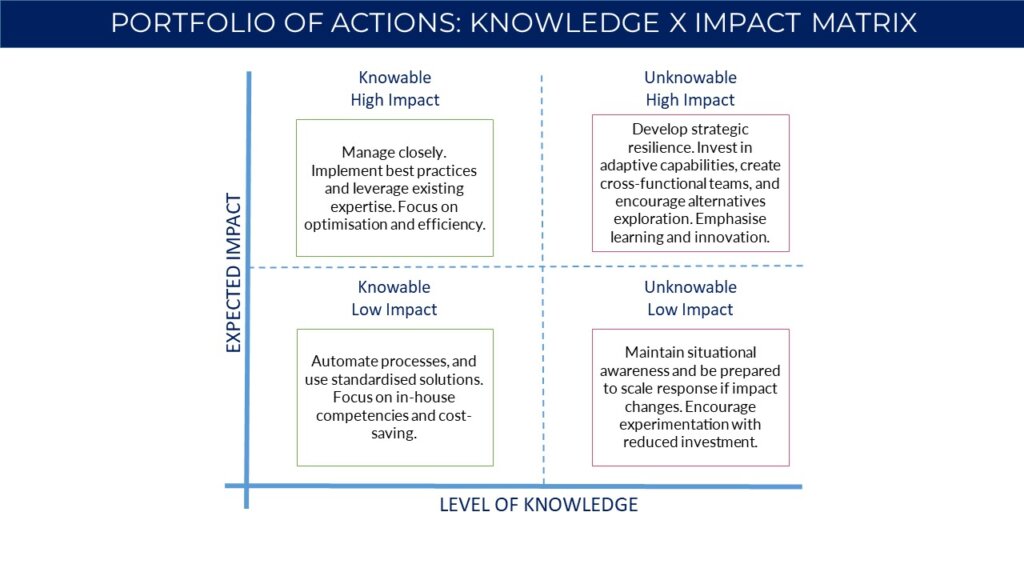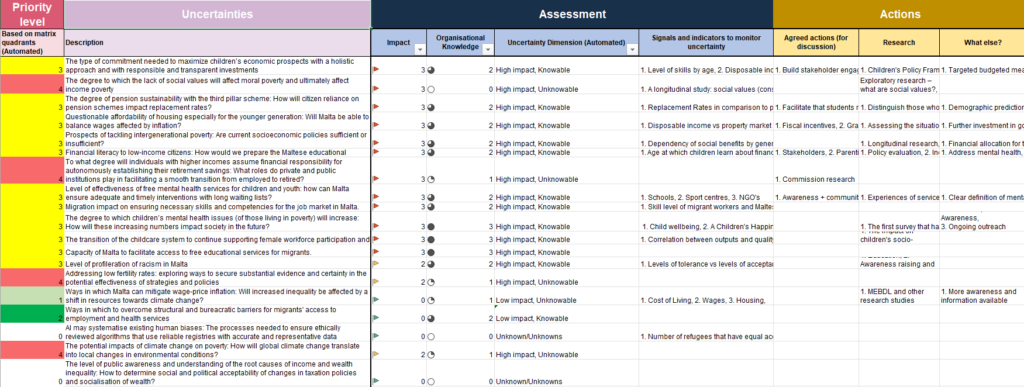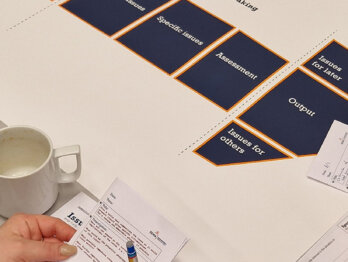Steps towards an Uncertainty Dashboard: Exploring the known and unknown in Malta

In a recent collaboration to address unpredictability in government planning, the Maltese Ministry for Social Policy and Children’s Rights (MSPC) and the OECD embarked on an ‘Uncertainty Scan’, a three-step strategic foresight initiative designed to reveal unexamined assumptions and “ghost scenarios” that often go unnoticed in strategic planning. The initiative challenged and refined the understanding of uncertainties, assessed their impact in strategy and introduced a tool inspired by the European Commission: the Uncertainty Dashboard. This prototype serves to systematically monitor and evaluate uncertainties that are critical for an organisation’s strategy development process. It has the potential to support organisations in:
- Coordinating knowledge and data about uncertainties across multiple teams
- Building consensus on priorities
- Identifying tailored capabilities, strategies and actions
- Providing a basis for commissioning research
- Identifying what knowledge different stakeholders can provide
Uncertainties can be identified by questioning our assumptions about trends [1] and exploring potential alternative outcomes of trends. For example, with the aging population trend, we can question the prospects of workforce shortages as retirees come to outnumber new entrants. We can also ask ourselves whether or not increased longevity translates into an improved quality of life that permits a continued contribution to society.
In the field of strategic foresight, the concept of uncertainty is fundamental, yet not as well understood as trends, mega-trends, and events. Uncertainty as a concept indicates factors, signals and drivers that are difficult to predict and to assign probability of occurring. Rather than treating uncertainty as an essential element with which to better explore long-term possibilities, it is often obscured in trends reports by jargon and acronyms, such as VUCA or TUNA, and thus overlooked. Uncertainties that can significantly impact the future and for which there is a lack of information and familiarity, both inside and outside of an organisation, are categorised as critical uncertainties. These critical uncertainties are, in fact, the basis for developing a set of challenging, relevant and possible future scenarios.
The OECD Observatory of Public Sector Innovation defines strategic foresight as the ability of an organisation to constantly perceive, make sense of, and act on ideas about the future as it emerges in the present. For governments and public administrations, strategic foresight complements traditional predictive and forecasting approaches that focus on resisting uncertainty and that lead to a single sequential pathway or linear view of the future. Solely adhering to a linear approach limits our ability to broaden boundaries of perception and to expand the awareness of emerging issues and situations.
As part of a multi-country project (LIMinal) funded by the European Commission’s Technical Support Instrument, the OECD has been working with partners in Malta on a pilot case, a short-term action research activity. MSPC has been preparing a renewed National Strategy for Poverty Reduction and Social Inclusion (2025-2035). The Ministry recognised that innovative approaches are needed to reach its poverty reduction and social inclusion goals and highlighted the importance of introducing strategic foresight as a complementary practice and capability to inform the preparation of the renewed strategy.
Learning from uncertainty with Malta
The ‘Uncertainty Scan’ with Malta was held in three steps as follows.
Step 1: Reframing trends into uncertainties
The main objective of this step is to reframe pre-identified trends into uncertainties using individual and collective insights from governmental and non-governmental entities.
How to – activities:
- Introduce a list of pre-identified trends from desk research and invite participants to select two-three trends each and add the most relevant uncertainties that are related to those same trends. The uncertainties should be both part of, and beyond, their immediate organisational context.
- Employ a Knowledge x Impact matrix (figure 1 below) and collectively explore the extent of participants’ organisational and external knowledge around uncertainties. Also, facilitate group discussions on the expected impact that uncertainties can have on strategy, such as Malta’s strategy for poverty reduction and social inclusion.
This process can provide an initial holistic view of the portfolio of actions for effectively managing and strategically responding to four main dimensions of uncertainties: Knowable/High Impact (manage closely); Unknowable/High Impact (develop strategic resilience); Unknowable/Low Impact (maintain situational awareness); Knowable/Low Impact (automate and standardise). Additionally, we reflected upon those uncertainties in a context where it is difficult to identify the necessary knowledge and make informed decisions, namely uncertainties with unknown impact and that are unknowable.

Step 2: Analysing and managing the different dimensions of uncertainty
In a follow-up session, we further analysed, clarified, and refined the identified uncertainties. Importantly, this step involved a broad group of stakeholders with different perspectives and access to insights based on their proximity to those affected by poverty and social exclusion. This step provided an opportunity to engage in strategic conversations and gather data to be integrated into the ‘Uncertainty Dashboard’.
How to – activities:
- Iteration and sensemaking: Use exercises to allow participants to reassess their level of knowledge about each uncertainty and its potential impact on a strategy or the future of a topic. For the online activity with MSPC we used a collaborative platform, such as Padlet, to receive written comments, collect results from a voting exercise, and facilitate a plenary discussion.
- Identify indicators: Through the exercises, aim to identify indicators that can be used to monitor the evolution of uncertainties and explore strategies that can generate further knowledge about uncertainties. Examples include engaging in cross-sectorial action and commissioning research.

Step 3: Development of an Uncertainty Dashboard
The Uncertainty Dashboard is a prototype tool (see figure 2 below) designed to encourage MSPC to explore uncertainties more systematically. All uncertainties from the matrix quadrants were inserted into the Dashboard and integrated with two operational sections (assessment and actions) to explore practical responses to the uncertainties that may influence the implementation of strategic objectives and actions for the Ministry’s renewed strategy.
How to – activities:
- Assessment: the dashboard monitors the level of existing knowledge about the uncertainty and the level of impact of a given uncertainty on strategy. Moreover, it introduces indicators to provide direction for further assessment of the uncertainty as well as to visualise its evolution overtime.
- Actions: the dashboard can include proposed actions to address or minimise an uncertainty, as well as propose, conduct and commission research that supports the implementation and the legitimacy of these actions.
| KNOWLEDGE X IMPACT | UNCERTAINTY | ASSESSMENT: INDICATOR(S) | ACTION(S) |
| Knowable and High impact | Prospects of tackling intergenerational poverty: Are current socioeconomic policies sufficient or insufficient? | Asset poverty: Poverty based on asset ownership.Food insecurity: Access to adequate and health foodHousing conditions: Housing affordability and quality.Education: Educational attainmentHealth: Health outcomes and access | Conduct longitudinal and qualitative researchFinancial allocation for target measuresBuild joint activities with Government, NGOs, academia and private institutions to coordinate research initiatives |
Lessons learned and MSPC assessment of the pilot
After concluding the pilot case, MSPC assessed the process based on four learning outcomes that can inform and be integrated into the development of the renewed national strategy.
1. Supporting learning about strategic foresight principles
This foresight process which focused on uncertainties has allowed MSPC to uncover assumptions of determinants such as AI and climate change which have not always been associated with poverty and social vulnerability.
2. Considering new processes for information gathering and decision-making
The Uncertainty Dashboard provides MSPC with a more systematic and structured approach for gathering, organising, and analysing information related to uncertainties. It serves as a new process for decision-makers to visualise early warning signals.
3. Identifying future uncertainties and challenges in poverty and social inclusion
The pilot facilitated a deeper understanding of the multifaceted nature of poverty and social exclusion among MSPC representatives, and served as a good basis for assisting in the identification of priorities and formulation of the national strategy.
4. Engaging relevant stakeholders
MSPC emphasised the collaborative nature of the pilot initiative, involving both governmental and non-governmental entities, which provided a high-level dialogue and knowledge exchange.
Together with MSPC we recognised the value of uncovering uncertainty as a catalyst for innovation and change. It can enable governments to more systematically manage and monitor different dimensions of uncertainty, and to explore new avenues for action and policy transformation.
[1] Schwartz, P. (1996), The Art of the Long View: Planning for the Future in an Uncertain World; Crown Business: New York, NY, USA, 1996.












